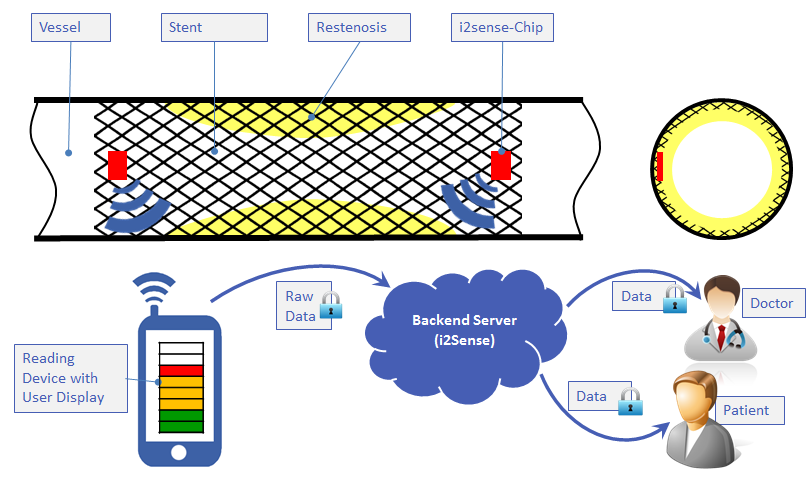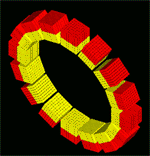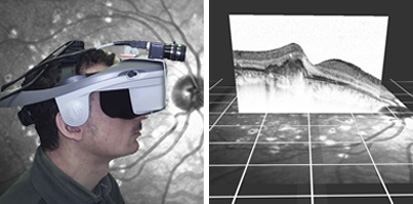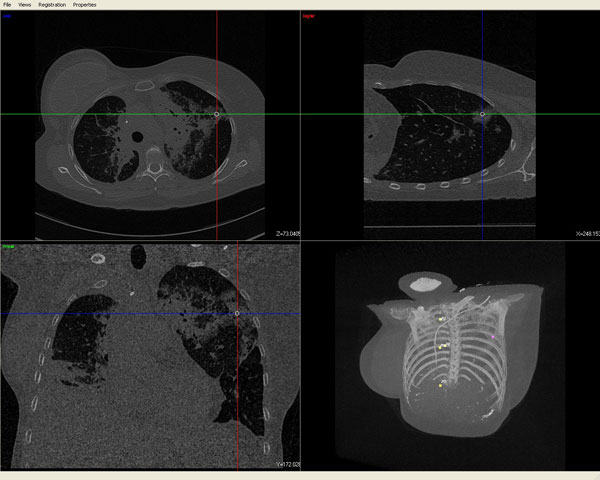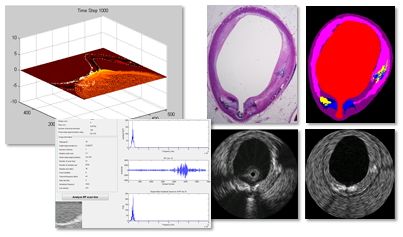Past CAMP Research Projects @ IFL
This website provides information about former research projects at
IFL. When visiting these pages, keep in mind that they are mostly not maintained anymore. In many cases, people responsible for these projects have already left the chair for Computer Aided Medical Procedures.
|
|
Atherosclerosis is deadliest disease in the world and occurs throughout vascular system like peripheral arteries, abdominal aorta, coronaries, etc. Balloon angioplasty and stenting are common treatment options, however, restenosis often happens with or without any sign of symptoms, which demands for repetitive expensive follow up routines. Within the i2Sense project we are working on an on-line/on-demand technology for monitoring of restenosis progression.
|
|
|
Subject of this project is the development of dedicated reconstruction algorithms for PET which take patient movements into account. Positron-emission-tomography (PET) is nowadays a well-established tool for diagnosing, staging and monitoring diseases in patients. However, due to the long acquisition times which are necessary for a PET scan, patient movements are often unavoidable. Patient motion during data acquisition can cause image blurring and even severe artifacts in the reconstructed image, thus posing a significant problem for further diagnosis and treatment. To date, available algorithms have been tested only on synthetic data since they rely on general transformation data of the patient which are currently not practically available. We aim at developing algorithms that work on partial transformation data that will be delivered e. g. by new laser cameras or com-bined PET/MRT machines.
|
|
|
The project addresses and combines several objectives of the topics Health 2010.1.2-1, such as novel multimodality imaging tools, including a single-photon (quantum) counting PET detector head for the purpose of detecting and quantifying morphologic and functional markers and of developing new biomarkers of tumoural processes at the preclinical and clinical levels. Moreover the endoscopic approach, combined with an unprecedented PET timing resolution will allow more sensitive, more precise, lower radiation dose and less invasive imaging and intervention on small internal structures and lesions towards earlier detection and patient-tailored treatment of asymptomatic cancer types.
|
|
|
Surgical workflow recovery is a crucial step towards the development of intelligent support systems in surgical environments. The objective of the project is to create a system which is able to recognize automatically the current steps of a surgical laparoscopic procedure using a set of signals recorded from the OR. The project adresses several issues such as the simultaneous recordings of various signals within the OR, the design of methods and algorithms for processing and interpreting the information, and finally the development of a convenient user interface to display context sensitive information inside the OR. The current clinical focus is on laparoscopic cholecystectomies but the concepts developed in the project also apply to laparoscopic surgeries of other kinds.
|
|
|
Age-related macular degeneration (AMD) is one of the leading causes of low vision worldwide without a medical solution. Nevertheless, enhancement of people's vision by means of mediated reality is conceivable. This project presents a head-mounted magnification system to enhance visual perception acquired with peripheral vision. A hybrid magnification technique is adjusted and implemented on a head-mounted display. Moreover, a system for modeling and correcting distorted vision is proposed. The system obtains a correction model by means of a deformable grid. To evaluate the system, a method for simulating distorted vision is applied. By superimposing the model on OCT macular images, it is suitable to identify macular features, which could help on the development of an automatic correction method.
|
[[][  ]] |
[[][Bio-Innovation: From clinical needs to solution concepts]]
Learn how to successfully identify unmet clinical needs within the clinical routine and work towards possible and realistic solutions to solve those needs. Students will get to know tools helping them to be successful innovators in medical technology. This will include all steps from needs finding and selection to defining appropriate solution concepts, including the development of first prototypes. Get introduced to necessary steps for successful idea and concept creation and realize your project in an interdisciplinary teams comprising of physicists, informations scientists and business majors. During the project phase, you are supported by coaches from both industry and medicine, in order to allow for direct and continuous exchange.
|
|
|
Stroke is the third leading cause of death in Germany. It is a neurology injury, whereby the oxygen supply to parts of the brain gets cut off. About 80% of these strokes are due to ischemia, i.e. an occlusion of a blood vessel leading to an interrupted blood flow. Stenosis inside the carotid artery imaged using four different MR weightings Special setting in this project is the arteria carotis. Plaque is most likely to develop at the branching of the arteria carotis communis into the arteria carotis interna (leading to the brain) and the arteria carotis externa. This can lead to an abnormal narrowing, called a stenosis. According to the American Heart Association these plaques can be divided into different types, based on their consistency and structure. Until now the decision about a surgery was only based on the degree of the stenosis and not on the type of plaque causing it. This is a faulty approach since there is a plaque type (Type IV) which constitutes a relevant clinical danger, although it does not necessary come along with a stenosis. Unlike most other image modalities MR images do not only give information about the degree of the stenosis, but also about the consistency of the plaque. Using different weighted MR images it is possible to correctly classify plaque into the types defined by the AHA. The main goal of this project is to create a classification tool based on T1, T2, Proton Density and 'Time of flight' weighted images. To achieve this goal the arteria carotis and the plaque have to be segmented from the images. Furthermore various features of the plaque have to be extracted in order to get information needed for the classification.
|
|
|
A common task during broncoscopy procedures is to biopsy peripheral lung tumors. The video bronchoscope is not capable to reach the peripheral lung nodes, but only the biopsy needle. Thus there is no video feedback, but only feedback of the current location of the biopsy tool by fluoroscopy imaging during the intervention. This exposes patient and surgical staff to additional radiation. Another drawback is that tumors can not be visualized on the fluoroscope images and they are only a projection, thus do not report the three dimensional position of the biopsy tool. Electromagnetic tracking is capable of tracking the tip of flexible instrument. A field generator with three orthogonal coils introduces current and thus generates a magnetic field. A sensor composed also of three orthogonal coils is capable to estimate its position and orientation with respect to a coordinate system defined by the field generator. Currently we investigate the combination of all available information for navigation and solutions to represent it in one unified user interface. This includes the measurements of the electromagnetic tracking system, the c-arm, techniques of virtual bronchoscopy, and other data. Furthermore, clinical evaluation is conducted. We define the clinical endpoint and show through studies that the procedure will benefit from the usage of the navigation system.
|
|
|
The project Augmented Reality Supported Patient Education and Consultation (Augmented Reality unterstützte Operationsaufklärung) aims at developing Augmented Reality (AR) supported communication tools for patient education. The development of the targeted systems involves disciplines reaching from image registration, human computer interaction and in-situ visualization to instructional design and perceptual psychology. As a primary clinical application, we determined breast reconstruction in plastic surgery.
|
|
|
We are simulating Ultrasound images from CT volumes by assuming a correlation between Hounsfield units and acoustic impedance. Rays are cast trough the CT volume to simulate the US image formation. Simulated Ultrasound from CT can be used for CT/Ultrasound registration by comparing a real US image to simulated ones. Another application of simulated US is training.
|
|
|
Intra-operative localization of non-superficial cancerous lesions in non-hollow organs like liver, kidney, etc is currently facilitated by intra-operative ultrasound (IOUS) and palpation. This yields a high rate of false positives due to benign abnormal regions and thus unnecessary resections with increased complications and morbidity. In this project we integrate functional nuclear information from gamma probes with IOUS, to provide a synchronized, real-time visualization that facilitates the detection of active tumors and metastases intra-operatively. The bet of this project is that the inclusion of an advanced, augmented visualization provides more reliability and confidence on classifying lesions prior to the resection.
|
|
|
In abdominal surgery, a laparoscopic ultrasound transducer is commonly used to detect lesions such as metastases. The determination and visualization of position and orientation of its flexible tip in relation to the patient or other surgical instruments can be of much help to (novice) surgeons utilizing the transducer intraoperatively. This difficult subject has recently been paid attention to by the scientific community. Electromagnetic tracking systems can be applied to track the flexible tip. However, the magnetic field can be distorted by ferromagnetic material.
We present a new method based on optical tracking of the laparoscope and magneto-optic tracking of the transducer, which is able to automatically detect and correct field distortions. This is used for a smooth augmentation of the B-scan images of the transducer directly on the camera images in real time.
|
|
|
In recent years, an increasing number of liver tumor indications were treated by minimally invasive laparoscopic resection. Besides the restricted view, a major issue in laparoscopic liver resection is the precise localization of the vessels to be divided. To navigate the surgeon to these vessels, pre-operative imaging data can hardly be used due to intra-operative organ deformations caused by appliance of carbon dioxide pneumoperitoneum and respiratory motion.
Therefore, we propose to use an optically tracked mobile C-arm providing cone-beam computed tomography imaging capability intra-operatively. After patient positioning, port placement, and carbon dioxide insufflation, the liver vessels are contrasted and a 3D volume is reconstructed during patient exhalation. Without any further need for patient registration, the volume can be directly augmented on the live laparoscope video. This augmentation provides the surgeon with essential aid in the localization of veins, arteries, and bile ducts to be divided or sealed.
Current research focuses on the intra-operative use and tracking of mobile C-arms as well as laparoscopic ultrasound, augmented visualization on the laparoscope's view, and methods to synchronize respiratory motion.
|
|
|
In minimally invasive tumor resection, the goal is to perform a minimal but complete removal of cancerous cells. In the last decades interventional beta probes supported the detection of remaining tumor cells. However, scanning the patient with an intraoperative probe and applying the treatment are not done simultaneously. The main contribution of this work is to extend the one dimensional signal of a nuclear probe to a four dimensional signal including the spatial information of the distal end of the probe. This signal can be then used to guide the surgeon in the resection of residual tissue and thus increase its spatial accuracy while allowing minimal impact on the patient.
|
|
|
PICOSEC (Pico-second Silicon photomultiplier-Electronics- & Crystal research) is an European Marie Curie training project. It aims to bring together early career researchers and experienced colleagues from across Europe, to take part in a structured, integrated and multidisciplinary training program for young researchers in an R&D project geared to develop a new class of ultra-fast photon detectors in PET and HEP. This R&D will be the core activity of a TOF-PET development for clinical applications and would open new perspectives in medical imaging and hence in the quality of patient treatment. The Consortium is composed of public and private organizations and based on a common research program, aiming to increase the skills exchange between public and private sectors.
The overall project is divided in to different work packages that focus on specific aims while working towards common project goal. Our work package (WP) 5 has been assigned with the following tasks,
1. Provide tracking solutions for flexible endoscopy, trans-rectal ultrasound probe (TRUS), and endoscopic imaging devices, and evaluate their robustness and accuracy.
2. Based on tracking and imaging data, reconstruct volumes of interest from flexible endoscopic or TRUS detectors.
3. For orientation, guidance to specific regions of interest, and, where appropriate, through specific scanning protocols, provide navigation solutions.
|
|
|
We introduce a framework to simulate intravascular ultrasound (IVUS) from histological sections. These sections were previously acquired along with real IVUS radiofrequency signals using single-element 40MHz transducer. After labeling and registering the section to the corresponding IVUS image, a virtual phantom was created, incorporating nuclei scatterer patterns. A finite differences simulation of the acoustic signal was performed, resulting in backscattered radiofrequency signals. These were used to process a B-mode image, which in turn was compared to the real IVUS image of the same section. A high image quality with a very promising correlation to the original IVUS images was achieved.
|
|
|
Learn how to successfully identify unmet clinical needs within the clinical routine and work towards possible and realistic solutions to solve those needs. Students will get to know tools helping them to be successful innovators in medical technology. This will include all steps from needs finding and selection to defining appropriate solution concepts, including the development of first prototypes. Get introduced to necessary steps for successful idea and concept creation and realize your project in an interdisciplinary teams comprising of physicists, informations scientists and business majors. During the project phase, you are supported by coaches from both industry and medicine, in order to allow for direct and continuous exchange.
|
